Experimental Study and Parameter Optimization of a Magnetic Coupled Piezoelectric Energy Harvester
Abstract
1. Introduction
2. Modeling and Analysis
2.1. Operation Principle
2.2. Modeling
2.3. Simulation Analysis of Different Modes
- The magnitude of the magnetic force is inversely proportional to the fourth power of the distance. The magnets at close distances are easy to fit at the attraction configuration, and cannot be automatically separated. This causes difficulties in actual assembly and application. Therefore, the repulsion mode is selected for analysis.
- The energy is proportional to the square of the amplitude. Compared with the double degree-of-freedom characteristic, the high performance is more efficient in practical applications. Thus, “Low beam repulsion mode” is selected with higher amplitude and bandwidth than the conventional configuration without tuning.
3. Experimental Platform Setup
4. Results and Discussion
4.1. Experimental Results
4.1.1. Static Analysis
4.1.2. Load Resistance Analysis
4.1.3. Key Parameters Analysis
- An optimal spacing D for each Br exists.
- As Br increases, the optimal spacing increases.
- The values of the respective optimized power in simulation are similar, both around 3.65 mW.
- Similar trends and conclusions can be obtained from experiments and simulations.
- The optimum value of the experiment is between 3.1 and 3.3 mW. Since the spacing between the scan is not short enough, the optimal value of the experiment is significantly smaller than the simulation, and the absolute optimal value may not be produced in the experiment.
4.1.4. Optimal Results Analysis
4.1.5. Different Acceleration Test
4.2. Comparison with Previous Works
4.3. Discussion
- Compared with the conventional cantilever beam energy harvester, the performance has been improved in terms of amplitude and frequency bandwidth by magnetic coupling. The increased performance increases the robustness of the system, which accommodates more complex operating conditions.
- This paper focuses on the peak voltage, and the peak voltage error under the optimal parameter experiments are less than 6%. Among them, the error is 3.82%, 5.30%, 5.85% under the acceleration condition of 1, 4, 10 m/s2. It can be concluded preliminarily that the error increases with the excitation, but it is still within the acceptable range. In terms of frequency, the peak frequencies of the experiments are both 0.1 Hz larger than the simulation. The main sources of the above errors are the calculation of magnetic force, experimental error, and simplified error of the lumped parameter model.
- The lumped parameter model of this paper can predict the characteristics of the system within acceptable error and can be used in the structural design. Parameter optimization should be operated in applications to maximize system performance. For example, in this paper, the amplitude can be increased by 35.0% and the 5 V bandwidth is increased by 66.7%.
- After parameter optimization, the structure in this paper can get more than 3 mW of energy, which is enough to provide energy for some low power consumption devices. For example, the wake-up receiver of wireless sensor networks achieves an ultra-low power consumption of 4.5 nW [38]. ADI’s commercial acceleration sensor ADXL362 consumes 3.6 μW at a sampling rate of 100 Hz, and the MCU ADuCM4050 achieves a low power consumption of 40 μA/MHz. Through a comprehensive power consumption consideration, the wireless sensor system can achieve consumption at “mW” or even “μW” level. Therefore, the energy demand can be met under the settings described in this paper. If the energy is not enough in some applications, a bimorph structure can be utilized to increase the energy.
- If further power is required, more advanced composite materials can be used to increase the power. For example, the novel magneto-mechano-electric material combines electromagnetic and piezoelectric mechanisms [39], and a 3D-skeletal architecture piezoelectric ceramics can get about 16 times higher energy than the conventional PZT [40]. These materials are all suitable for the structure proposed in this paper because the performance is optimized by increasing the deformation of the cantilever beam. However, it may be increased in terms of cost and additional circuits, and the durability of the new materials should be considered.
- From the perspective of cost savings, ordinary PZT materials can be used. It is important to note that the magnetic flux density parameter needs to be set smaller. Since the PZT is very brittle, the large magnetic force will increase the deflection and reduce the service life.
- From the perspective of practical design, the structure of this paper increases the quality and volume of the system, which is increased by about 100%. In terms of cost, since piezoelectric materials are the main cost source, the cost increase is expected to be less than 20%. Therefore, under the condition of satisfying the quality and volume limitation, the structure has a certain cost performance by increasing the power of 35.0%.
5. Conclusions
Author Contributions
Funding
Conflicts of Interest
References
- Babayo, A.A.; Anisi, M.H.; Ali, I. A review on energy management schemes in energy harvesting wireless sensor networks. Renew. Sustain. Energy Rev. 2017, 76, 1176–1184. [Google Scholar] [CrossRef]
- Yadav, A.; Goonewardena, M.; Ajib, W.; Dobre, O.A.; Elbiaze, H. Energy management for energy harvesting wireless sensors with adaptive retransmission. IEEE Trans. Commun. 2017, 65, 5487–5498. [Google Scholar] [CrossRef]
- Adu-Manu, K.S.; Adam, N.; Tapparello, C.; Ayatollahi, H.; Heinzelman, W. Energy-Harvesting Wireless Sensor Networks (EH-WSNs): A Review. ACM Trans. Sens. Netw. 2018, 14, 10. [Google Scholar] [CrossRef]
- Bai, Y.; Jantunen, H.; Juuti, J. Energy Harvesting Research: The Road from Single Source to Multisource. Adv. Mater. 2018, 30. [Google Scholar] [CrossRef] [PubMed]
- Orrego, S.; Shoele, K.; Ruas, A.; Doran, K.; Caggiano, B.; Mittal, R.; Kang, S.H. Harvesting ambient wind energy with an inverted piezoelectric flag. Appl. Energy 2017, 194, 212–222. [Google Scholar] [CrossRef]
- Wang, H.; Jasim, A.; Chen, X. Energy harvesting technologies in roadway and bridge for different applications—A comprehensive review. Appl. Energy 2018, 212, 1083–1094. [Google Scholar] [CrossRef]
- Karami, M.A.; Inman, D.J. Powering pacemakers from heartbeat vibrations using linear and nonlinear energy harvesters. Appl. Phys. Lett. 2012, 100, 042901. [Google Scholar] [CrossRef]
- Bassani, G.; Filippeschi, A.; Ruffaldi, E. Nonresonant Kinetic Energy Harvesting Using Macrofiber Composite Patch. IEEE Sens. J. 2018, 18, 2068–2076. [Google Scholar] [CrossRef]
- Ahmed, R.; Mir, F.; Banerjee, S. A review on energy harvesting approaches for renewable energies from ambient vibrations and acoustic waves using piezoelectricity. Smart Mater. Struct. 2017, 26, 085031. [Google Scholar] [CrossRef]
- Yang, Z.; Zhou, S.; Zu, J.; Inman, D. High-Performance Piezoelectric Energy Harvesters and Their Applications. Joule 2018, 2, 642–697. [Google Scholar] [CrossRef]
- Foong, F.M.; Thein, C.K.; Ooi, B.L.; Yurchenko, D. Increased power output of an electromagnetic vibration energy harvester through anti-phase resonance. Mech. Syst. Signal Process. 2019, 116, 129–145. [Google Scholar] [CrossRef]
- Feng, Y.; Yu, Z.; Han, Y. High-performance gap-closing vibrational energy harvesting using electret-polarized dielectric oscillators. Appl. Phys. Lett. 2018, 112, 032901. [Google Scholar] [CrossRef]
- Fang, Z.W.; Zhang, Y.W.; Li, X.; Ding, H.; Chen, L.Q. Integration of a nonlinear energy sink and a giant magnetostrictive energy harvester. J. Sound Vib. 2017, 391, 35–49. [Google Scholar] [CrossRef]
- Wei, C.; Jing, X. A comprehensive review on vibration energy harvesting: Modelling and realization. Renew. Sustain. Energy Rev. 2017, 74, 1–18. [Google Scholar] [CrossRef]
- Kim, S.; Towfeeq, I.; Dong, Y.; Gorman, S.; Rao, A.M.; Koley, G. P (VDF-TrFE) film on PDMS substrate for energy harvesting applications. Appl. Sci. 2018, 8, 213. [Google Scholar] [CrossRef]
- Reilly, E.K.; Burghardt, F.; Fain, R.; Wright, P. Powering a wireless sensor node with a vibration-driven piezoelectric energy harvester. Smart Mater. Struct. 2011, 20, 125006. [Google Scholar] [CrossRef]
- Twiefel, J.; Westermann, H. Survey on broadband techniques for vibration energy harvesting. J. Intell. Mater. Syst. Struct. 2013, 24, 1291–1302. [Google Scholar] [CrossRef]
- Dechant, E.; Fedulov, F.; Fetisov, L.Y.; Shamonin, M. Bandwidth Widening of Piezoelectric Cantilever Beam Arrays by Mass-Tip Tuning for Low-Frequency Vibration Energy Harvesting. Appl. Sci. 2017, 7, 1324. [Google Scholar] [CrossRef]
- Usharani, R.; Uma, G.; Umapathy, M.; Choi, S.B. A Novel Piezoelectric Energy Harvester Using a Multi-Stepped Beam with Rectangular Cavities. Appl. Sci. 2018, 8, 2091. [Google Scholar] [CrossRef]
- Liu, H.; Lee, C.; Kobayashi, T.; Tay, C.J.; Quan, C. Investigation of a MEMS piezoelectric energy harvester system with a frequency-widened-bandwidth mechanism introduced by mechanical stoppers. Smart. Mater. Struct. 2012, 21, 035005. [Google Scholar] [CrossRef]
- Wu, Y.; Badel, A.; Formosa, F.; Liu, W.; Agbossou, A. Nonlinear vibration energy harvesting device integrating mechanical stoppers used as synchronous mechanical switches. J. Intell. Mater. Syst. Struct. 2014, 25, 1658–1663. [Google Scholar] [CrossRef]
- Liu, S.; Cheng, Q.; Zhao, D.; Feng, L. Theoretical modeling and analysis of two-degree-of-freedom piezoelectric energy harvester with stopper. Sens. Actuators A Phys. 2016, 245, 97–105. [Google Scholar] [CrossRef]
- Fan, K.; Tan, Q.; Liu, H.; Zhang, Y.; Cai, M. Improved energy harvesting from low-frequency small vibrations through a monostable piezoelectric energy harvester. Mech. Syst. Signal Process. 2019, 117, 594–608. [Google Scholar] [CrossRef]
- Erturk, A.; Hoffmann, J.; Inman, D.J. A piezomagnetoelastic structure for broadband vibration energy harvesting. Appl. Phys. Lett. 2009, 94, 254102. [Google Scholar] [CrossRef]
- Ibrahim, A.; Towfighian, S.; Younis, M.I. Dynamics of transition regime in bistable vibration energy harvesters. J. Vib. Acoust. 2017, 139, 051008. [Google Scholar] [CrossRef]
- Stanton, S.C.; McGehee, C.C.; Mann, B.P. Nonlinear dynamics for broadband energy harvesting: Investigation of a bistable piezoelectric inertial generator. Physica D 2010, 239, 640–653. [Google Scholar] [CrossRef]
- Challa, V.R.; Prasad, M.G.; Shi, Y.; Fisher, F.T. A vibration energy harvesting device with bidirectional resonance frequency tunability. Smart Mater. Struct. 2008, 17, 015035. [Google Scholar] [CrossRef]
- Challa, V.R.; Prasad, M.G.; Fisher, F.T. Towards an autonomous self-tuning vibration energy harvesting device for wireless sensor network applications. Smart Mater. Struct. 2011, 20, 025004. [Google Scholar] [CrossRef]
- Zhang, G.C.; Chen, L.Q.; Ding, H. Forced vibration of tip-massed cantilever with nonlinear magnetic interactions. Int. J. Appl. Mech. 2014, 6, 1450015. [Google Scholar] [CrossRef]
- Zhang, G.C.; Chen, L.Q.; Li, C.P.; Ding, H. Primary resonance of coupled cantilevers subjected to magnetic interaction. Meccanica 2017, 52, 807–823. [Google Scholar] [CrossRef]
- Firoozy, P.; Khadem, S.E.; Pourkiaee, S.M. Broadband energy harvesting using nonlinear vibrations of a magnetopiezoelastic cantilever beam. Int. J. Eng. Sci. 2017, 111, 113–133. [Google Scholar] [CrossRef]
- Tang, L.; Yang, Y. A nonlinear piezoelectric energy harvester with magnetic oscillator. Appl. Phys. Lett. 2012, 101, 094102. [Google Scholar] [CrossRef]
- Abdelkefi, A.; Barsallo, N. Nonlinear analysis and power improvement of broadband low-frequency piezomagnetoelastic energy harvesters. Nonlinear Dyn. 2016, 83, 41–56. [Google Scholar] [CrossRef]
- Yuan, T.C.; Yang, J.; Chen, L.Q. A harmonic balance approach with alternating frequency/time domain progress for piezoelectric mechanical systems. Mech. Syst. Signal Process. 2019, 120, 274–289. [Google Scholar] [CrossRef]
- Erturk, A.; Inman, D.J. On mechanical modeling of cantilevered piezoelectric vibration energy harvesters. J. Intell. Mater. Syst. Struct. 2008, 19, 1311–1325. [Google Scholar] [CrossRef]
- Dutoit, N.E.; Wardle, B.L.; Kim, S.G. Design considerations for MEMS-scale piezoelectric mechanical vibration energy harvesters. Integr. Ferroelectr. 2005, 71, 121–160. [Google Scholar] [CrossRef]
- Vokoun, D.; Beleggia, M.; Heller, L.; Šittner, P. Magnetostatic interactions and forces between cylindrical permanent magnets. J. Magn. Magn. Mater. 2009, 321, 3758–3763. [Google Scholar] [CrossRef]
- Jiang, H.; Wang, P.H.P.; Gao, L.; Sen, P.; Kim, Y.H.; Rebeiz, G.M.; Hall, D.A.; Mercier, P.P. 24.5 A 4.5 nW wake-up radio with− 69dBm sensitivity. In Proceedings of the 2017 IEEE International Solid-State Circuits Conference (ISSCC), San Francisco, CA, USA, 5–9 February 2017; pp. 416–417. [Google Scholar]
- Chu, Z.; Annapureddy, V.; PourhosseiniAsl, M.; Palneedi, H.; Ryu, J.; Dong, S. Dual-stimulus magnetoelectric energy harvesting. MRS Bull. 2018, 43, 199–205. [Google Scholar] [CrossRef]
- Zhang, Y.; Sun, H.; Jeong, C.K. Biomimetic Porifera Skeletal Structure of Lead-Free Piezocomposite Energy Harvesters. ACS Appl. Mater. Interfaces 2018, 10, 35539–35546. [Google Scholar] [CrossRef]

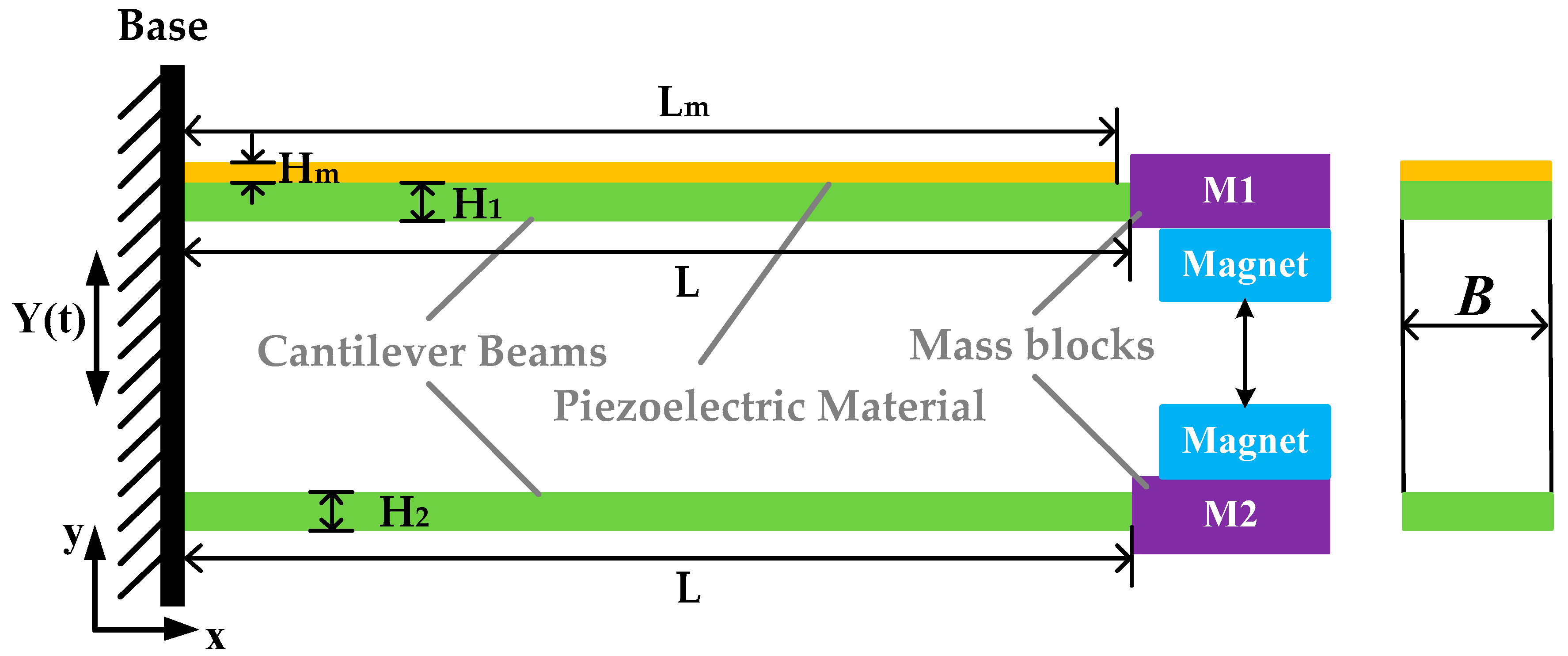
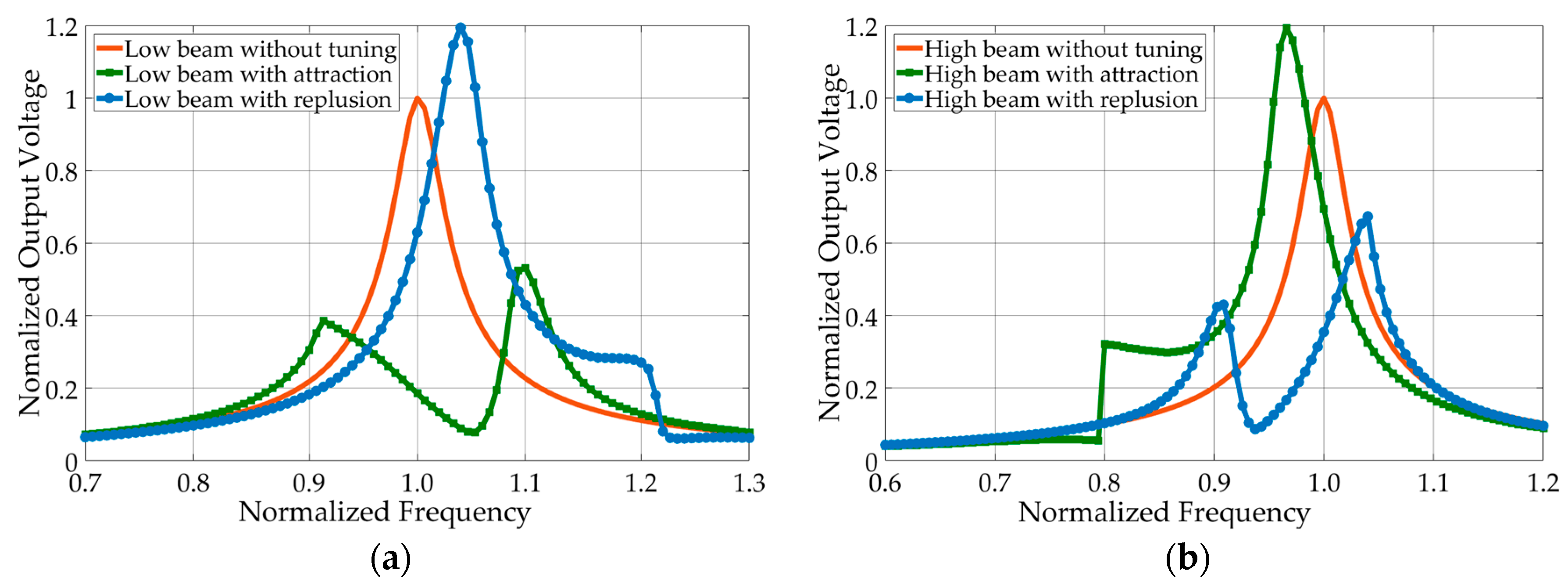


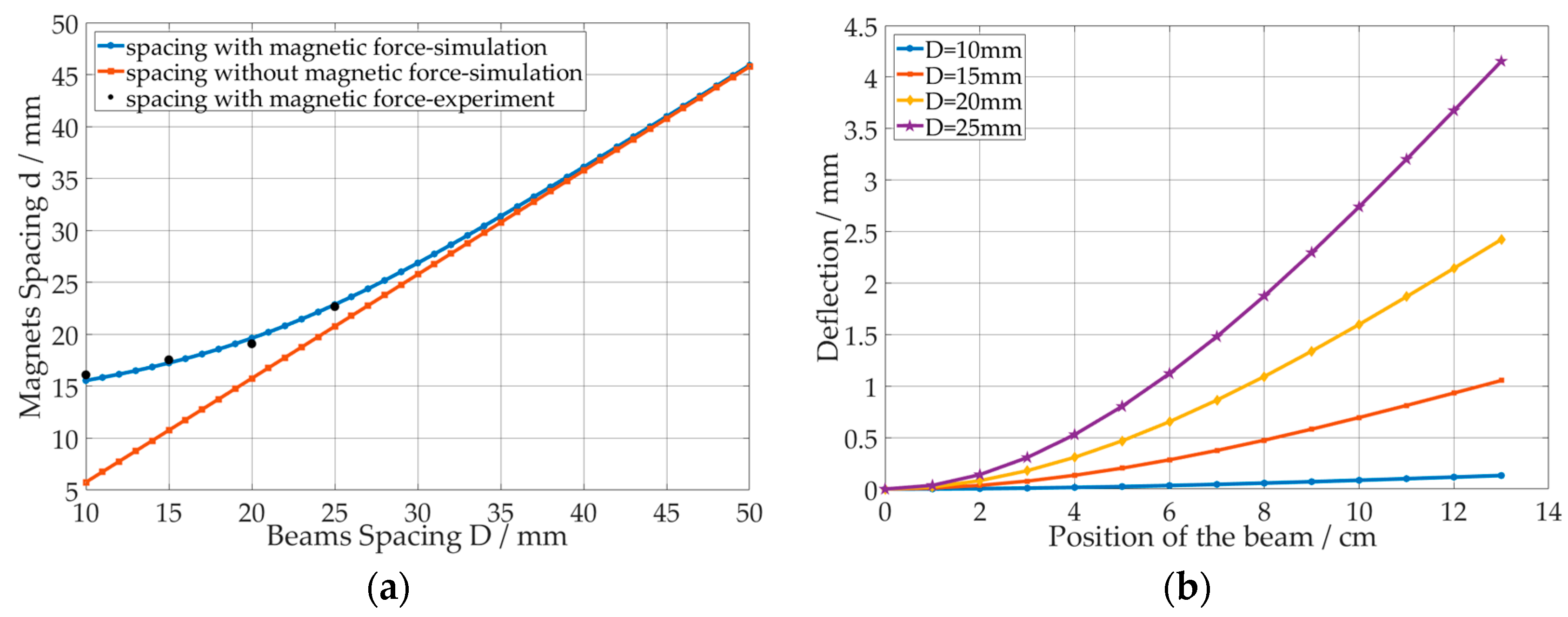

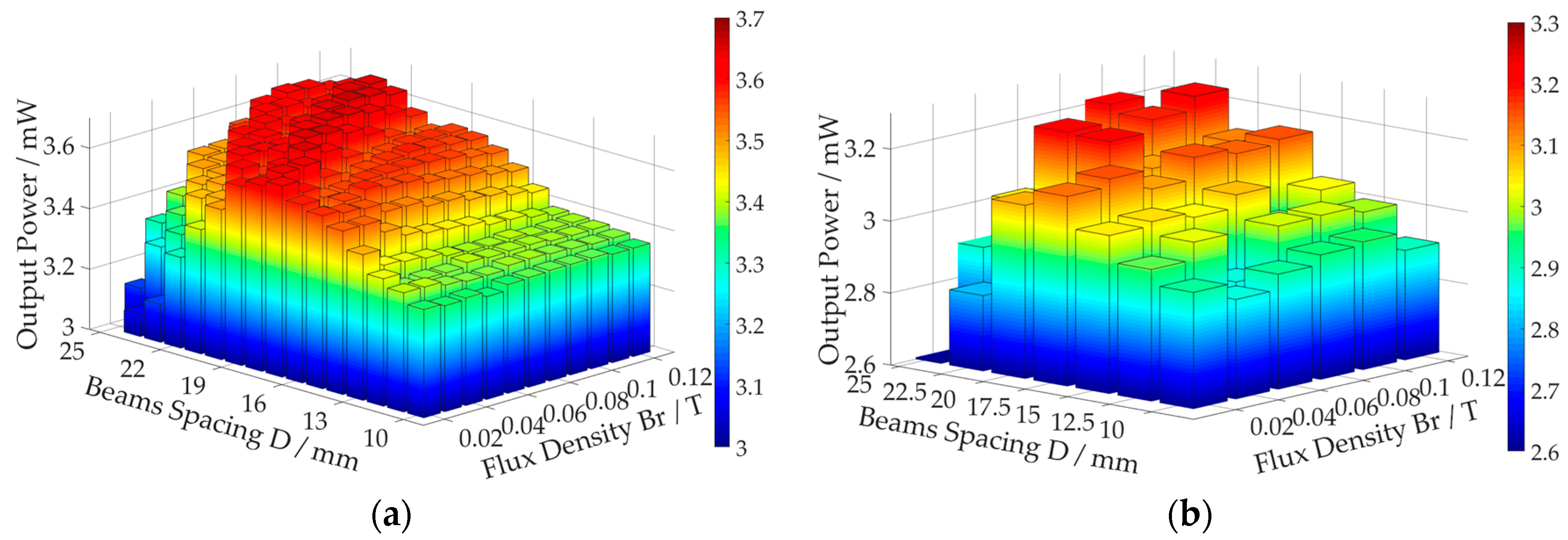
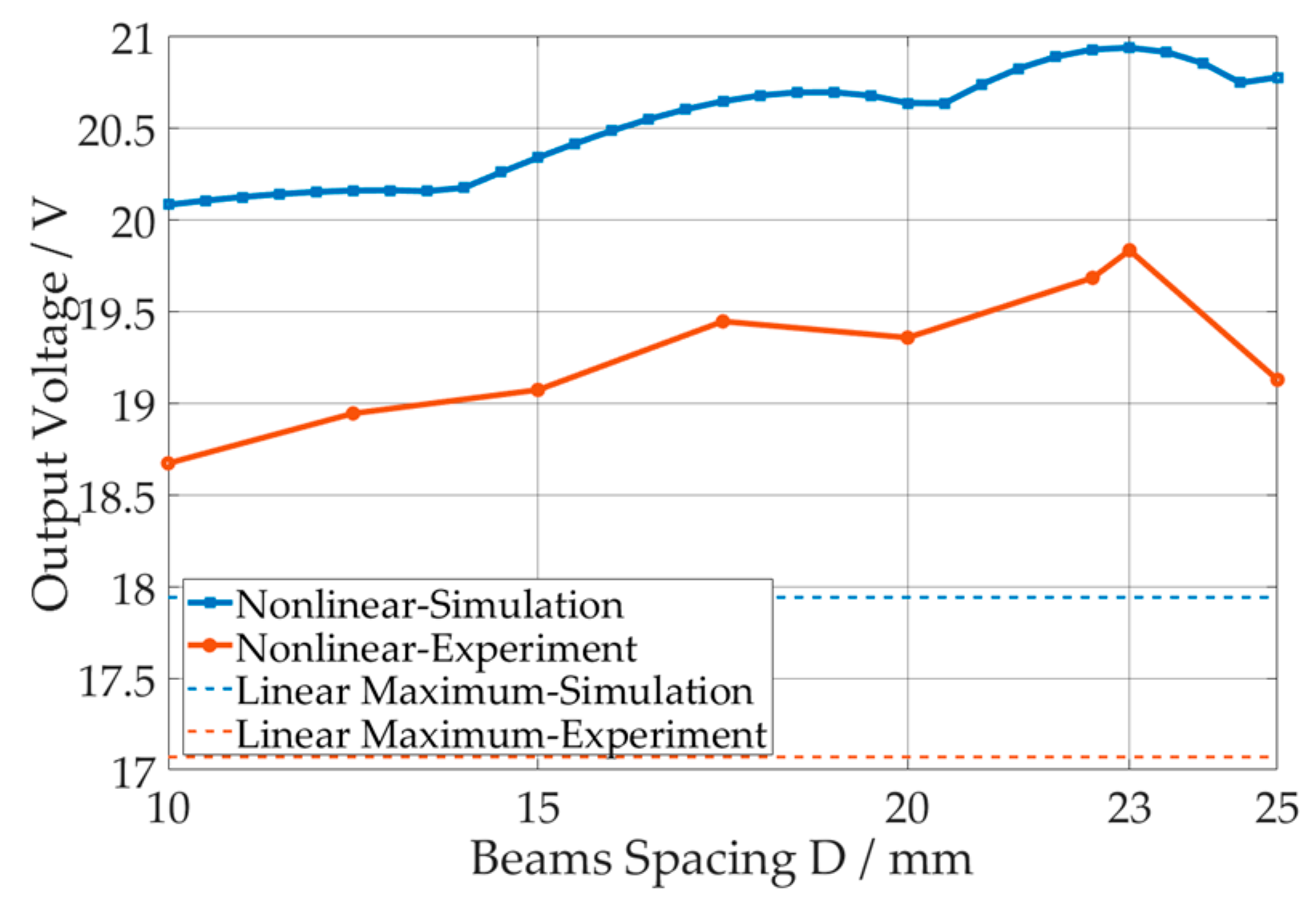
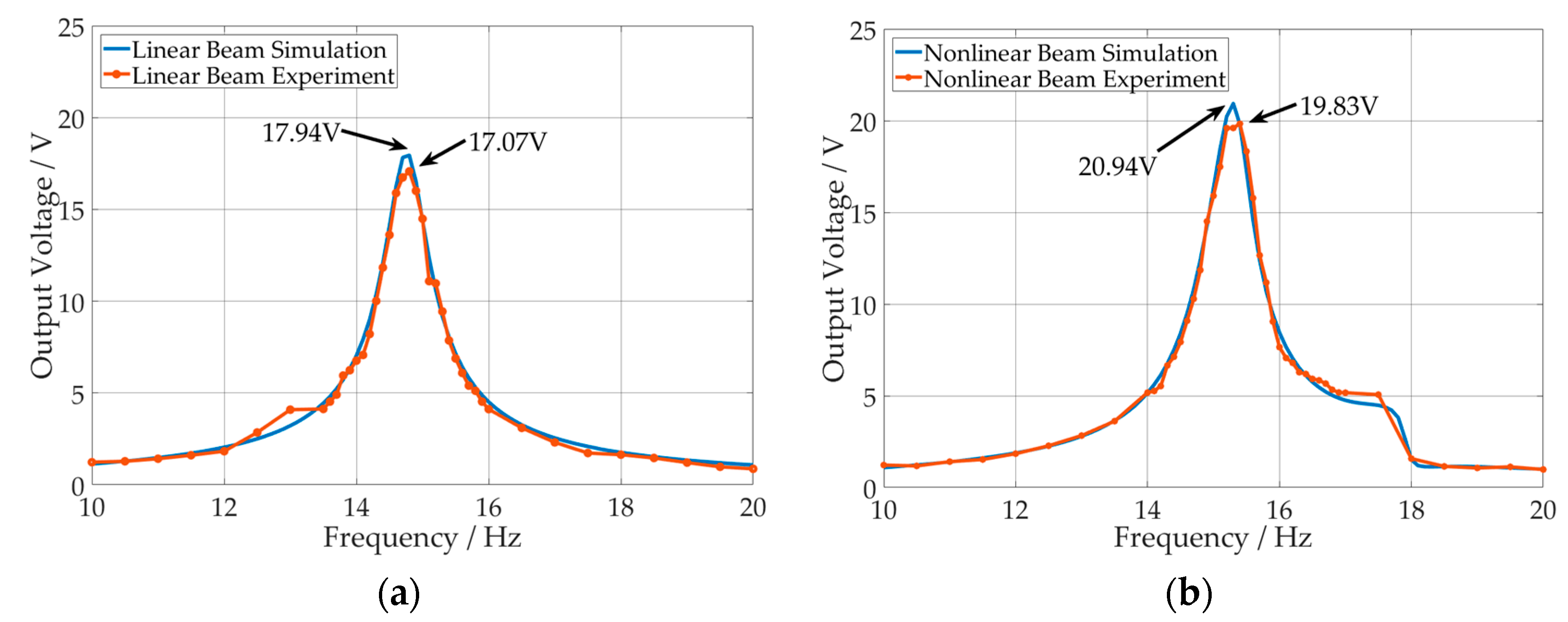



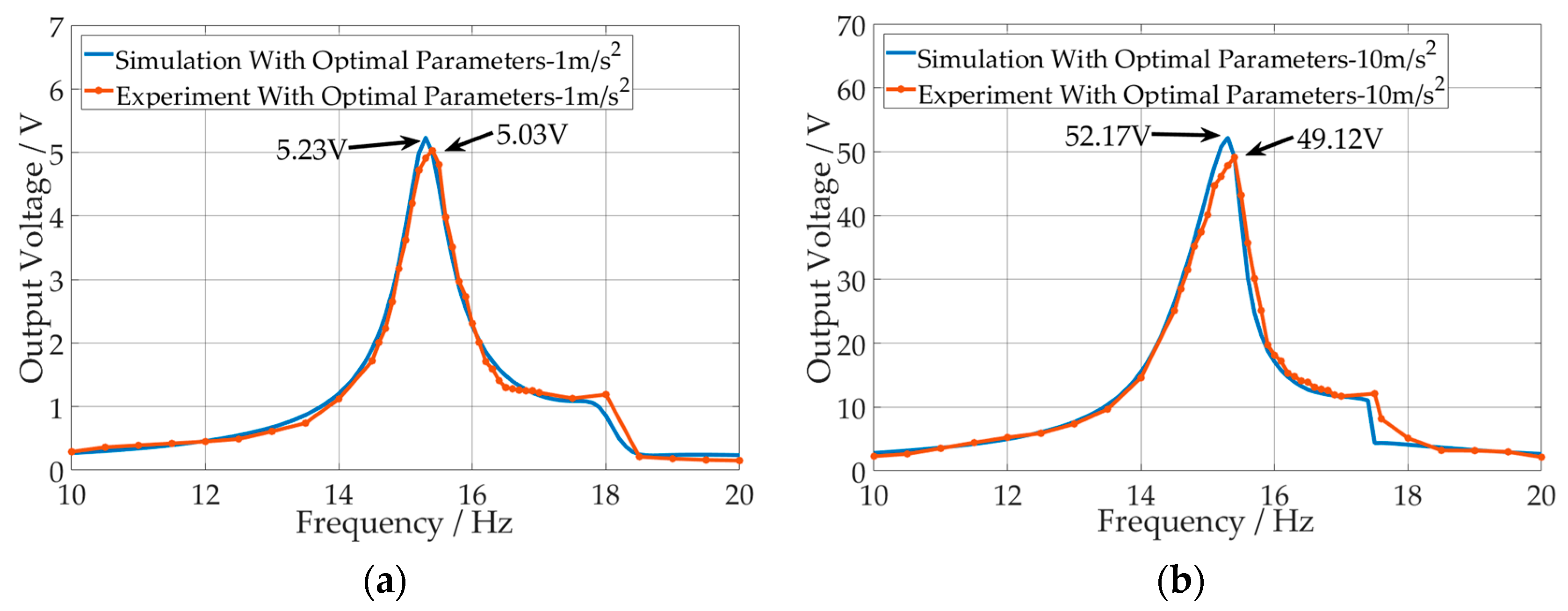
| Symbol | Meaning | Symbol | Meaning |
|---|---|---|---|
| M | Equivalent mass | H | Height |
| C | Equivalent damping | W | Width |
| K | Equivalent stiffness | L | Length |
| m | Weight of the mass | ρ | Density |
| Cp | Capacity of piezoelectric material | Fmag | Magnetic force |
| Vp | Output voltage | Br | Flux density of the magnet |
| R | Load resistance | μair | Vacuum permeability |
| Θ | Electromechanical coupling coefficient | r | Radius of the magnet |
| μ | Compensation factor | h | Thickness of the magnet |
| E | Elastic Modulus of the beam | mmag | Weight of the magnet |
| I | Moment of inertia | d | Spacing of the magnets |
| w | Deflection | D | Spacing of the beams’ fixed ends |
| Beam Classification | Low Frequency | High Frequency |
|---|---|---|
| Attraction | Softening Double degree-of-freedom | Softening High Performance |
| Repulsion | Hardening High Performance | Hardening Double degree-of-freedom |
| Component | Material | Size (mm) | Weight (g) |
|---|---|---|---|
| Cantilever beam1 | Al-6061T | 130 × 20 × 0.5 | 3.55 |
| Cantilever beam2 | Al-6061T | 130 × 20 × 0.75 | 5.32 |
| Piezoelectric pitch | MFC-M8514-P2 | 101 × 20 × 0.21 | 2.01 |
| Magnet | Nd–Fe–B | R10 × 2 | 4.72 |
| Mass | Al | / | 1.02 |
| Frame | Acrylic | / | / |
| Ref. | Estimated Size | Resonance Frequency | Excitation | Voltage | Power | Power Density |
|---|---|---|---|---|---|---|
| (cm3) | (Hz) | (m/s2) | (V) | (μW) | (μW/cm3) | |
| [11] | 217.5 | 17.2 | 1 | 0.16 | 7400 | 34.02 |
| [15] | 0.6 | 30 | 17.5 | 5.8 | 18.56 | 30.93 |
| [19] | 139.95 | 21.02 | 10V a | 61.55 | 6600 | 47.16 |
| [22] | 14.4 | 21.4 | 3 | 22.35 | 429 | 29.8 |
| [23] | 3.09 | Random | 1 | 21 | 48 | 15.53 |
| [This Work] | 63.6 | 15.3 | 4 | 19.83 | 3277 | 51.53 |
© 2018 by the authors. Licensee MDPI, Basel, Switzerland. This article is an open access article distributed under the terms and conditions of the Creative Commons Attribution (CC BY) license (http://creativecommons.org/licenses/by/4.0/).
Share and Cite
Rui, X.; Li, Y.; Liu, Y.; Zheng, X.; Zeng, Z. Experimental Study and Parameter Optimization of a Magnetic Coupled Piezoelectric Energy Harvester. Appl. Sci. 2018, 8, 2609. https://doi.org/10.3390/app8122609
Rui X, Li Y, Liu Y, Zheng X, Zeng Z. Experimental Study and Parameter Optimization of a Magnetic Coupled Piezoelectric Energy Harvester. Applied Sciences. 2018; 8(12):2609. https://doi.org/10.3390/app8122609
Chicago/Turabian StyleRui, Xiaobo, Yibo Li, Yue Liu, Xiaolei Zheng, and Zhoumo Zeng. 2018. "Experimental Study and Parameter Optimization of a Magnetic Coupled Piezoelectric Energy Harvester" Applied Sciences 8, no. 12: 2609. https://doi.org/10.3390/app8122609
APA StyleRui, X., Li, Y., Liu, Y., Zheng, X., & Zeng, Z. (2018). Experimental Study and Parameter Optimization of a Magnetic Coupled Piezoelectric Energy Harvester. Applied Sciences, 8(12), 2609. https://doi.org/10.3390/app8122609





